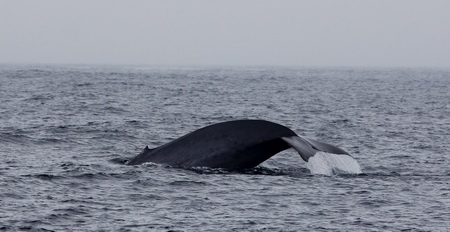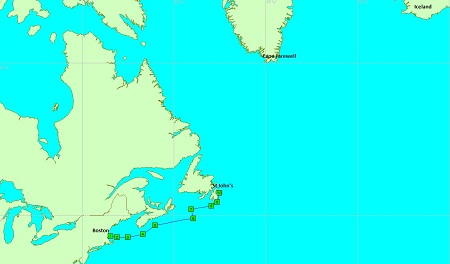Song of the Whale left Boston last week with five new team members, a new mainsail, new hydrophone, plenty of fresh food and much anticipation about the upcoming voyage. The passage plan aims to pass the coastlines of Canada and Greenland and onto Iceland, covering historical whaling grounds and potential habitat for the endangered North Atlantic right whale, rarely studied offshore habitats of the blue whale, and famous fishing banks from times gone by.

The excitement of our departure from Boston was temporarily put on hold, as we had to turn back just out of harbour due to alternator problems. However, once back in Boston, the problems was fixed in no time, and the next day Song of the Whale left Boston for real and headed out through the Gulf of Maine towards Canadian waters. Joining our regular team are Yan Guilbault, a right whale scientist from New England Aquarium, Eamon MacMahon, a wilderness photographer and artist, and Vassili Papastavrou from IFAW, who has travelled straight from the IWC in Panama, full of news of the recent meetings.
A few days into the passage, we passed close to Roseway Bank, and watched the blows of fin and humpback whales in all directions out to the horizon. From there to the Gully, an underwater canyon well known as a beaked whale hotspot. It certainly lived up to its reputation, as we were experienced the most amazing spectacle of four beaked whales breaching repeatedly in unison, and Northern bottlenose whales surfacing in groups of up to six animals around the boat. For many of us, this was a first sighting of Northern bottlenose whales; it was a real thrill to see their bulbous heads and distinctive beaks so close up, and to detect their high frequency clicks on the hydrophones. The exciting sightings continued — the next day, SOTW started a long transect across the Laurentian Channel and within the first mile we were greeted with the huge blows of blue whales surfacing near and far around the boat. We estimated that we were surrounded by some ten animals, although we passed close enough to only a few for photo ID before continuing on our journey. Soon the infamous dense damp fog of the Grand Banks rolled in, limiting our visibility and ability to continue visual observations. But the hydrophones were busy as ever, recording sperm whale clicks and dolphin whistles constantly for the next 24 hours.

The SOTW team is not even a third of the way through this trip so far, yet the sightings and detections have been overwhelming. Although we have seen nine different species, an encounter with North Atlantic right whales has, however, so far eluded us. But after a quick fuel stop in Saint John’s, Newfoundland, we will head out past the Flemish Cap towards Greenland and the ancient whaling grounds of Cape Farewell. This is a route that centuries ago may have taken us through right whale feeding grounds, and plentiful opportunities for sightings. Whether any right whales still inhabit these waters in 2012 remains to be seen…

Sorry, comments are closed for this post.